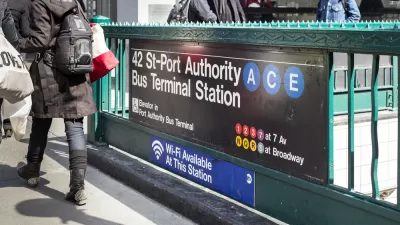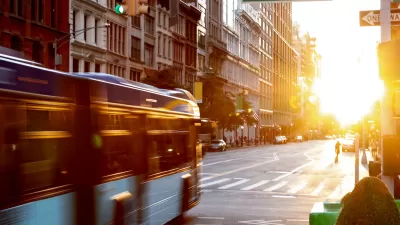Mobility advocates say the city must do more to make transit and alternative transportation modes more convenient for drivers.

Despite the city issuing "Gridlock Alerts," New Yorkers are driving into the city at similar rates as before, writes Julianne Cuba. According to mobility advocates, this is "a result of the mayor’s failure to create policies that get people out of cars and into mass transit on days when the city knows long in advance that roads and neighborhoods will be turned into pollution-, noise- and stress-filled parking lots." Local officials want the mayor to do more to cut traffic by implementing immediate measures such as emergency bus lanes. "We can not return to the status quo — it’s imperative that we seize this moment and create lasting change in the Central Business District," said Manhattan Council Member Keith Powers.
Such measures aren't new to the Big Apple: the city has enacted pop-up bus lanes and high-occupancy vehicle policies before, notably after 9/11 and during 2005's transit strike.
"Last summer, Riders Alliance was one of several advocacy groups to demand the mayor make room for 40 miles of 'emergency' dedicated bus lanes to help long-suffering transit riders — many of them low-income essential workers — as cars started flooding back onto roads. And the MTA even one-upped that, asking for 60 miles of bus lanes to speed up the city’s recovery."
But the requests fell on deaf ears, as the city only installed roughly 16 miles of dedicated lanes by the end of 2020, even as the number of cars entering the city rises above pre-pandemic rates and the MTA is forced to suspend bus service due to heavy traffic. "Meanwhile, bus riders suffer and emergency response times spike. Whether it’s emergency bus lanes or busways, HOV restrictions, transit discounts, the city and state need to do more to ensure the delivery of essential services in public space," says Danny Pearlstein of Riders Alliance. As Doug Gordon of The War on Cars podcast puts it, "'Bus service is suspended because of heavy traffic' is one of those things that should provoke an all-hands-on-deck response from city government." So far, that isn't the case.
FULL STORY: Mayor Issues ‘Gridlock Alert’ Days, But Driving Continues Unabated Because of Poor Policies: Advocates

Maui's Vacation Rental Debate Turns Ugly
Verbal attacks, misinformation campaigns and fistfights plague a high-stakes debate to convert thousands of vacation rentals into long-term housing.

Planetizen Federal Action Tracker
A weekly monitor of how Trump’s orders and actions are impacting planners and planning in America.

In Urban Planning, AI Prompting Could be the New Design Thinking
Creativity has long been key to great urban design. What if we see AI as our new creative partner?

King County Supportive Housing Program Offers Hope for Unhoused Residents
The county is taking a ‘Housing First’ approach that prioritizes getting people into housing, then offering wraparound supportive services.

Researchers Use AI to Get Clearer Picture of US Housing
Analysts are using artificial intelligence to supercharge their research by allowing them to comb through data faster. Though these AI tools can be error prone, they save time and housing researchers are optimistic about the future.

Making Shared Micromobility More Inclusive
Cities and shared mobility system operators can do more to include people with disabilities in planning and operations, per a new report.
Urban Design for Planners 1: Software Tools
This six-course series explores essential urban design concepts using open source software and equips planners with the tools they need to participate fully in the urban design process.
Planning for Universal Design
Learn the tools for implementing Universal Design in planning regulations.
planning NEXT
Appalachian Highlands Housing Partners
Mpact (founded as Rail~Volution)
City of Camden Redevelopment Agency
City of Astoria
City of Portland
City of Laramie





























